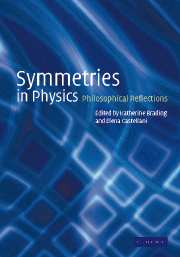Book contents
- Frontmatter
- Contents
- List of contributors
- Preface
- Copyright acknowledgements
- 1 Introduction
- Part I Continuous symmetries
- Part II Discrete symmetries
- Part III Symmetry breaking
- 17 Classic texts: extracts from Curie and Weyl
- 18 Cross fertilization in theoretical physics: the case of condensed matter and particle physics
- 19 On the meaning of symmetry breaking
- 20 Rough guide to spontaneous symmetry breaking
- 21 Spontaneous symmetry breaking: theoretical arguments and philosophical problems
- Part IV General interpretative issues
- Index
17 - Classic texts: extracts from Curie and Weyl
Published online by Cambridge University Press: 08 October 2009
- Frontmatter
- Contents
- List of contributors
- Preface
- Copyright acknowledgements
- 1 Introduction
- Part I Continuous symmetries
- Part II Discrete symmetries
- Part III Symmetry breaking
- 17 Classic texts: extracts from Curie and Weyl
- 18 Cross fertilization in theoretical physics: the case of condensed matter and particle physics
- 19 On the meaning of symmetry breaking
- 20 Rough guide to spontaneous symmetry breaking
- 21 Spontaneous symmetry breaking: theoretical arguments and philosophical problems
- Part IV General interpretative issues
- Index
Summary
Introduction
I think that there is interest in introducing into the study of physical phenomena the symmetry arguments familiar to crystallographers.
For example, an isotropic body may have a rectilinear or rotational motion. If liquid, it may have turbulence. If solid, it may be compressed or twisted. It may be in an electric or magnetic field. It may carry an electric or thermal current. It may be traversed by unpolarized or linearly, circularly, elliptically, etc. polarized light. In each case a certain characteristic asymmetry is necessary at each point of the body. These asymmetries are even more complex if one assumes that several phenomena coexist in the same medium or if they take place in a crystallized medium, which already possesses, by its constitution, a certain asymmetry.
Physicists often utilize symmetry conditions, but generally neglect to define the symmetry in a phenomenon, for sufficiently often these symmetry conditions are simple and quite obvious a priori.
When teaching physics, it would be better to state these questions openly: In the study of electricity, for example, one should state almost immediately the characteristic symmetry of the electric field and of the magnetic field. One can then use these notions to simplify proofs.
From a general point of viewthe idea of symmetry can be linked to the concept of dimension: These two fundamental concepts are respectively characteristic of the medium in which a phenomenon occurs and the quantity which serves to evaluate its intensity.
- Type
- Chapter
- Information
- Symmetries in PhysicsPhilosophical Reflections, pp. 311 - 314Publisher: Cambridge University PressPrint publication year: 2003
- 2
- Cited by



